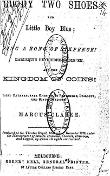Described as a 'fairy extravaganza' with songs to operatic and other music, the plot outline, as published in the Australasian, shows an abundance of satire aimed at topical issues and events. Notable references were the Franco-Prussian War, Melbourne politics, personalities, and issues such as debased currency and financial swindlers (17 December 1870, p.786). Margaret Williams notes, too, that although this is one of Clarke's happiest works, cynicism about the stockbroking world became a recurring theme throughout the pantomime (Australia on the Popular Stage, p.9).
The story concerns Goody Two Shoes, whose dearest wish is to become a Collins Street belle, and who has been given a lucky sixpence by the fairy Prudence. Speculation (a witch) also gives Goody Two Shoes a gift (self-conceit) in order to counteract the good gift of Fairy Prudence. Speculation then trades a pair of shoes for the sixpence after appealing to Goody's vanity and, as a consequence, the young lady finds herself being forced into marrying the witch's son, Rumbuskin. The marriage is postponed, however, by the actions of King Heydiddle-diddle-'em (Monarch of Swindles, Shares and Shams; Head of the Counterfeit Family; and a very bad Sovereign). Supported by his Army of Shams, he wars with and finally defeats King Gold, 'first cousin to the Almighty Dollar, and called familiarly the Great Spondulick' (aided by his Army of Coins). Prudence then steps in and, with the help of Little Boy Blue, attempts a rescue of King Gold (using a magic mirror). Counter-attacking, Speculation turns off light and causes the mirror to become useless.
The advertised Synopsis of Scenery and Incidents is as follows:
Scene 1. Glowworm Gully.
Scene 2. A Mysterious One.
Scene 3. Cottage of Goody Two Shoes.
Scene 4. The Valley of Fairy Ferns and Grand Ballet (introducing the pets of the ballet and a galaxy of Coryphees).
Scene 5. The Realm of Toys: Peace.
Scene 6. Pavilion of King Gold in the Kingdom of Coins.
Scene 7. The Gates of the Palace of Hey Diddle Diddle-'Em.
Scene 8. The Capital (without cash) of the Realm of Shams.
Scene 9. The Everlasting Staircase in the Empire of Gravity, seen through the pane of the bowels of the Earth.
Transformation Scene comprising A Chaotic Conglomerate of Circumfluent Clouds dissolving into the Glen of Gloom; The Appearance of Oberon the Fairy King; The Invocation; Coruscations of the Crystal Cataract; Fairy Forms of Florescent Fantasy reposing upon the Garden of Gossamer in Gayest Glittering Garb; and A Fascinating Fanciful Floral Fete, disclosing the Home of the Spirit of the Rose.
Harlequinade
(Synopsis of scenes from Argus, 26 December 1879, p.8).
 4704729679988133619.jpg
4704729679988133619.jpg
 Goody Two Shoes and Little Boy Blue ; Or, Sing a Song of Sixpence! Harlequin Heydiddle-Diddle-'em, and the Kingdom of Coins
single work
pantomime
fantasy
-
Nine scenes
Goody Two Shoes and Little Boy Blue ; Or, Sing a Song of Sixpence! Harlequin Heydiddle-Diddle-'em, and the Kingdom of Coins
single work
pantomime
fantasy
-
Nine scenes

